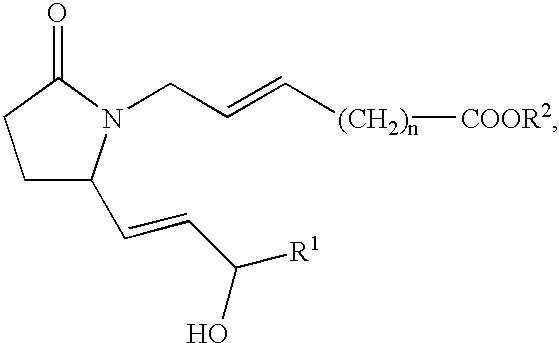Methods of treatment with selective EP4 receptor agonists
a technology of ep4 receptor and selective agonist, which is applied in the direction of biocide, drug composition, and elcosanoid active ingredients, can solve the problems of increased intraocular pressure or ocular hypertension, undesired side effects, etc., and achieve the effect of reducing the patency of the ductus arteriosus
- Summary
- Abstract
- Description
- Claims
- Application Information
AI Technical Summary
Benefits of technology
Problems solved by technology
Method used
Image
Examples
preparation 1
5-[3-(2R-Hydroxymethyl-5-oxo-pyrrolidin-1-yl)-propyl]-thiophene-2-carboxylic acid methyl ester
[0282]Step A: 5R-(tert-Butyl-dimethyl-silanyloxymethyl)-1-prop-2-ynyl-pyrrolidin-2-one. To a solution of 5R-(tert-butyl-dimethyl-silanyloxymethyl)-pyrrolidin-2-one (Tetrahdedron Asymmetry 1996, 7, 2113) (10.24 g, 44.6 mmol) in DMF (650 mL) at 0° C. was added NaHMDS (1M in THF, 49 mL, 49 mmol) dropwise. The reaction mixture was mechanically stirred at room temperature for 2 h to yield a thick suspension. The reaction mixture was cooled to 0° C. and propargyl bromide (80% in toluene, 5.0 mL, 45 mmol) in DMF (50 mL) was added slowly. The reaction mixture was stirred at 0° C. for 2 h and at room temperature for 0.5 h. Aqueous saturated ammonium chloride (700 mL) and water (300 mL) were added. The solution was washed with EtOAc (3×600 mL). The organic solutions were combined, washed with water (4×300 mL) followed by brine (1×300 mL). The organic solution was dried (Na2SO4), filtered and concentr...
preparation 2
7-(2R-Hydroxymethyl-5-oxo-pyrrolidin-1-yl)-heptanoic acid ethyl ester
[0286]Analogous to the procedure described for Preparation 1, Step A, the anion derived from 5R-(tert-butyl-dimethyl-silanyloxymethyl)-pyrrolidin-2-one (18.83 g, 82.1 mmol) and NaHMDS (1M in THF, 90 mL, 90 mmol) was alkylated with ethyl 7-bromoheptanoate (16 mL, 82 mmol). The reaction mixture was stirred at 60° C. for 16 h and was worked-up analogous to that described for Preparation 1, Step A. The crude residue was dissolved in MeOH (600 mL) and 1N HCl (300 mL) was added. The solution was stirred for 3 h and the volatiles were removed in vacuo. The aqueous solution was diluted with CH2Cl2 (300 mL) and the organic solution was washed with water (2×75 mL) followed by brine (1×75 mL). The organic solution was dried (Na2SO4), filtered and concentrated. Purification by medium pressure chromatography (EtOAc) provided 7-(2R-hydroxymethyl-5-oxo-pyrrolidin-1-yl)-heptanoic acid ethyl ester (21.2 g). 1H NMR (CDCl3) δ 4.12 (q...
preparation 3
7-(2R-Hydroxymethyl-5-oxo-pyrrolidin-1-yl)-heptanenitrile
[0287]Analogous to the procedure described for Preparation 1, Step A, the anion derived from 5R-(tert-butyl-dimethyl-silanyloxymethyl)-pyrrolidin-2-one (20 g, 87 mmol) and NaHMDS (1M in THF, 96 mL, 96 mmol) was alkylated with 7-bromoheptanenitrile (13 mL, 87 mmol). The reaction mixture was stirred at 60° C. for 24 h and was worked-up analogous to that described for Preparation 1, Step A. The crude residue was dissolved in MeOH (350 mL) and 1N HCl (154 mL) was added. The solution was stirred for 2 h and the volatiles were removed in vacuo. The aqueous solution was washed with CH2Cl2 (3×200 mL) and the organic solutions were combined and washed with brine (1×150 mL). The organic solution was dried (Na2SO4), filtered and concentrated. Purification by medium pressure chromatography (1% MeOH in EtOAc to 4% MeOH in EtOAc) provided 7-(2R-hydroxymethyl-5-oxo-pyrrolidin-1-yl)-heptanenitrile (10.3 g). 1H NMR (CDCl3) δ 3.76 (dd, 1H), 3.6...
PUM
 Login to View More
Login to View More Abstract
Description
Claims
Application Information
 Login to View More
Login to View More - R&D
- Intellectual Property
- Life Sciences
- Materials
- Tech Scout
- Unparalleled Data Quality
- Higher Quality Content
- 60% Fewer Hallucinations
Browse by: Latest US Patents, China's latest patents, Technical Efficacy Thesaurus, Application Domain, Technology Topic, Popular Technical Reports.
© 2025 PatSnap. All rights reserved.Legal|Privacy policy|Modern Slavery Act Transparency Statement|Sitemap|About US| Contact US: help@patsnap.com



